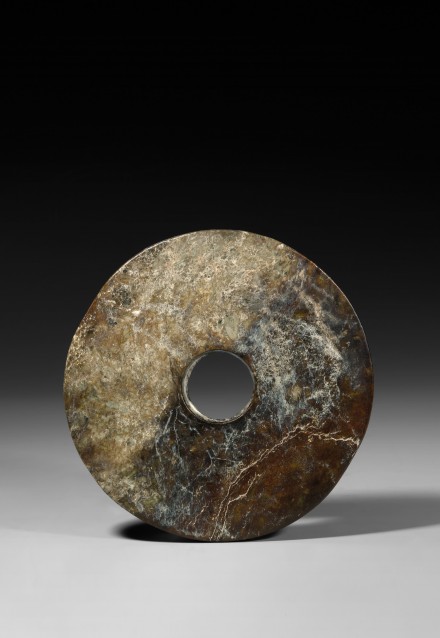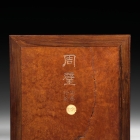J.J. Lally & Co., Oriental Art / New York City, New York
Menu
1.
A LARGE NEOLITHIC DARK GREEN JADE BI DISC
Liangzhu Culture, circa 3300 – 2250 B.C.
with thick flat sides and straight outer edge, polished to a smooth lustrous surface all over, the central circular aperture drilled from both sides with a narrow ledge remaining in the middle, the very dark green, almost black jade with olive-brown and pale cloudy mottling; Chinese wood fitted box with brocade lining and inset burl wood panel bearing the carved inscription: Zhou bi (周璧) Tao Zhai zhen cang (陶齋珍藏).
Diameter 7 5⁄8 inches (19.3 cm)
Provenance
From the Collection of Viceroy Duanfang (端方, 1861-1911)
From the Collection of Eugene Meyer (1875-1959) and
Agnes E. Meyer (1887-1970)
A Liangzhu jade bi disc of very similar form and size unearthed at the Wenjiashan site, Zhejiang province is illustrated in the catalogue of the special exhibition at the Arthur M. Sackler Museum of Art and Archaeology at Beijing University, by Qin and Fang (eds.), Quanli yu xinyang: Liangzhu yizhi qun kaogu tezhan (Power in Things: New Perspectives on Liangzhu), Beijing, 2015, p. 223, pl. II-2-10b, with description on p. 389.
Compare also other similar Liangzhu Neolithic jade discs in the British Museum, illustrated by Rawson, Chinese Jade from the Neolithic to the Qing, London, 1995, p. 131, fig. 2; in the Freer Gallery of Art, Washington, D.C., illustrated by Murray in “Neolithic Chinese Jades in the Freer Gallery of Art,” Orientations, November 1983, p. 14, fig. 1; and in the Metropolitan Museum of Art, New York, illustrated by Watt in The Metropolitan Museum of Art Bulletin, New York, Summer 1990, p. 10, no. 7.
新石器時代 良渚玉璧 徑 19.3 厘米
出處 端方舊藏、邁爾夫婦舊藏
Additional Images (Touch to enlarge)
1.
A LARGE NEOLITHIC DARK GREEN JADE BI DISC
Liangzhu Culture, circa 3300 – 2250 B.C.
Diameter 7 5⁄8 inches (19.3 cm)
